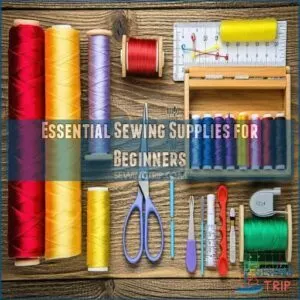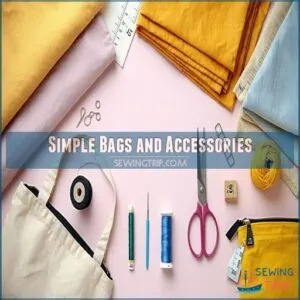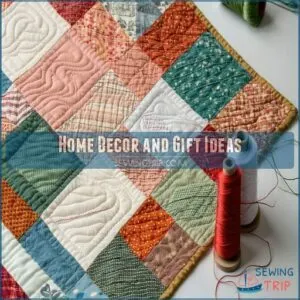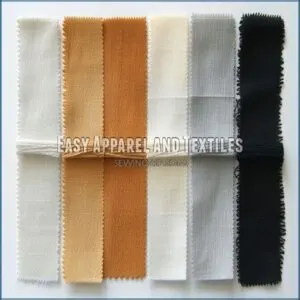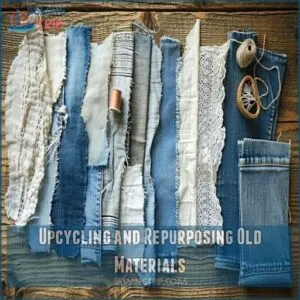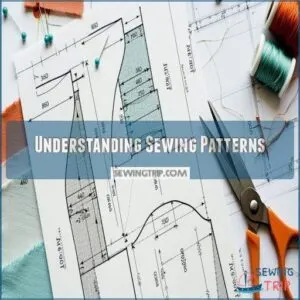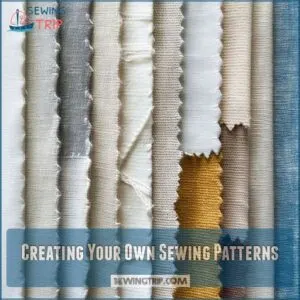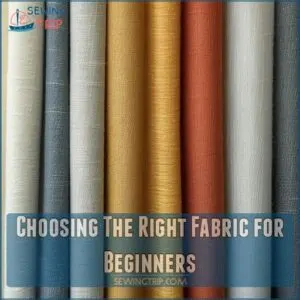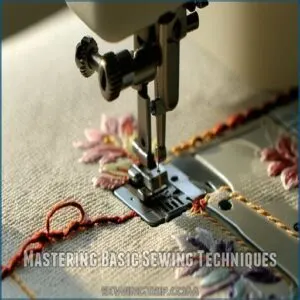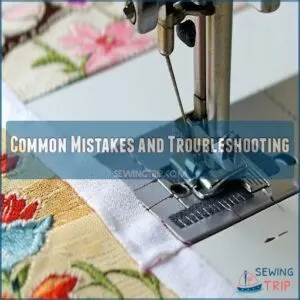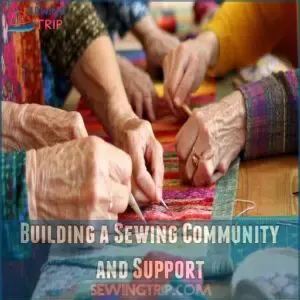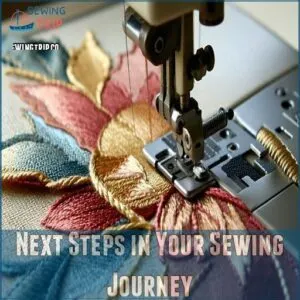This site is supported by our readers. We may earn a commission, at no cost to you, if you purchase through links.
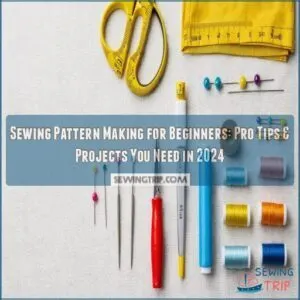
Sewing pattern making for beginners starts with the basics: gather your toolkit (think sharp scissors, measuring tape, and fabric markers), then master essential techniques like taking accurate measurements and understanding pattern symbols.
You’ll start small with simple projects like tote bags or pillowcases – perfect for practicing straight stitches and seam pressing.
Don’t worry about perfection; even seasoned sewists started somewhere! Transform old clothes into new treasures as you build confidence.
With the right tools and techniques at your fingertips, you’ll soon be creating custom-fit pieces that’ll make your friends ask, "Where’d you get that?
Table Of Contents
- Key Takeaways
- Essential Sewing Supplies for Beginners
- Beginner-Friendly Sewing Projects
- Understanding Sewing Patterns
- Creating Your Own Sewing Patterns
- Choosing The Right Fabric for Beginners
- Mastering Basic Sewing Techniques
- Common Mistakes and Troubleshooting
- Building a Sewing Community and Support
- Next Steps in Your Sewing Journey
- Frequently Asked Questions (FAQs)
- Conclusion
Key Takeaways
- You’ll need essential tools to start pattern making—invest in sharp scissors, a measuring tape, fabric markers, and a reliable sewing machine for professional results.
- Your first projects should be simple items like tote bags or pillowcases, which will help you master basic techniques like straight stitches and seam pressing without getting overwhelmed.
- You can create well-fitting patterns by taking accurate body measurements, adding proper ease allowance (1–2 inches for fitted clothes, 3–4 inches for loose styles), and making test garments before cutting expensive fabric.
- You’ll find success with natural fibers like cotton when starting out—they’re easier to handle, more forgiving for beginners, and work well with basic sewing machines.
Essential Sewing Supplies for Beginners
You’ll need more than just a needle and thread to start your sewing adventure.
but don’t worry – we’ll help you gather all the right tools without breaking the bank.
Just like a chef needs their favorite spatula and mixing bowls, you’ll discover that having the proper sewing supplies will make your creative projects much more enjoyable and successful.
Sewing Machine and Equipment
Three essential pieces of equipment kickstart your sewing journey: a reliable sewing machine, basic presser feet, and the right needle types.
You’ll want to master bobbin winding and get comfortable with machine maintenance – trust me, it’s not as scary as it sounds!
If you’re feeling fancy, a serger can take your projects up a notch, but it’s not necessary for beginners.
Fabric Selection and Preparation
Picking the right fabric can make or break your sewing projects.
Before you start, always pre-wash fabrics to prevent surprises later.
Different fabric types behave uniquely – cotton’s perfect for beginners, while silks might drive you nuts. For pattern matching success, lay everything out before cutting efficiently.
Keep your fabric stash organized in a cool, dry space to avoid that dreaded musty smell. Different fabric types and pre-washing fabrics are important.
Basic Sewing Tools and Notions
Now that you’ve got your fabric ready, let’s talk about the tools that’ll make your sewing journey smoother. You’ll need a well-stocked sewing kit with these game-changers:
- Sharp fabric scissors (trust me, keep these away from paper!), pins with colorful heads, and a magnetic pin cushion
- A seam ripper (your new best friend), measuring tape, and fabric marking tools
- Quality thread that matches your fabric, and a variety of machine needles
Measuring and Fitting Essentials
Getting your body measurements right is like having a secret weapon for perfect-fitting clothes.
You’ll need a flexible measuring tape and a buddy to help capture accurate numbers.
Start with your bust, waist, and hips – these are your pattern-making foundation.
Don’t forget to add ease allowance for comfort, typically 1-2 inches for fitted clothes and 3-4 inches for loose styles.
Beginner-Friendly Sewing Projects
You’ll love starting your sewing journey with these fun, no-sweat projects.
That’ll have you feeling like a pro in no time.
From cozy pillowcases to stylish tote bags, we’ve picked the perfect starter projects.
These starter projects won’t leave you tangled up in thread or ready to throw your sewing machine out the window.
Simple Bags and Accessories
Start your sewing journey with easy tote bags and zipper pouches that’ll boost your confidence.
These beginner sewing patterns are perfect for practicing straight lines and basic techniques.
You’ll love watching fabric choices transform into functional accessories.
Try a simple crossbody bag or wallet first – they’re quick wins that teach you pattern adjustments naturally.
Add personal flair with embellishment ideas like contrasting straps or decorative stitching. beginner sewing patterns easy tote bags functional accessories
Home Decor and Gift Ideas
Moving from bags to home decor opens up a world of creative possibilities.
You’ll love making DIY wall art and fabric baskets that add personality to any room.
Transform old textiles into stunning quilt patterns or craft thoughtful sewing gifts like table runners and pillowcases.
These beginner sewing patterns are perfect for practice – plus, there’s nothing better than saying "I made that!" when guests admire your handmade home decor.
Easy Apparel and Textiles
Your first foray into beginner-friendly patterns doesn’t need to be intimidating.
The Naya T-Shirt takes under an hour and fits like a dream, while the Luna Tank’s simple design makes it perfect for quick sewing projects.
Want something fancier? Try the Etty Camisole – it’s adaptable into a dress!
These easy sewing patterns use simple fabric choices, and they’re perfect for mastering basic techniques.
These are easy sewing patterns.
Upcycling and Repurposing Old Materials
Looking for sustainable sewing projects? Upcycling old materials isn’t just eco-friendly – it’s a goldmine for creative DIY sewing projects.
From transforming worn-out jeans into trendy tote bags to giving new life to vintage tablecloths, repurposed textiles offer endless possibilities for beginners.
By choosing the right materials and techniques, like those outlined in sustainable sewing practices, you can create beautiful, long-lasting items.
- Turn old t-shirts into cozy quilts or shopping bags
- Convert worn jeans into sturdy aprons or pot holders
- Transform vintage sheets into summer dresses
- Repurpose sweaters into mittens or winter accessories
Understanding Sewing Patterns
You’ll be amazed at how sewing patterns work like a treasure map, guiding you step by step to create beautiful, professional-looking projects.
Whether you’re working with store-bought patterns or making your own, you’ll soon discover that understanding these paper guides isn’t as tricky as it might seem at first glance.
Pattern Symbols and Notations
Once you’ve picked your beginner projects, those mysterious markings on sewing patterns start making sense.
Think of pattern symbols as your sewing roadmap.
Notches tell you where pieces connect, grainlines show fabric direction, and those little triangles mark where to match seam allowances.
It’s like learning a secret language that’ll transform flat pieces into amazing 3D creations. Pretty cool, right?
Sizing and Fit Considerations
Now that you’ve decoded those pattern symbols, let’s talk size – because patterns aren’t one-size-fits-all.
Start by taking accurate body measurements with a flexible tape measure.
Remember, pattern sizes often run differently from ready-to-wear clothes. Check the pattern’s ease allowance too – it’s the extra wiggle room that makes your garment comfortable.
Common fit issues pop up when these numbers don’t match your actual measurements.
Modifying and Adjusting Patterns
Getting your sewing patterns to fit just right doesn’t have to be a headache.
Whether you’re tweaking length, adjusting ease, or modifying basic sewing patterns for a custom look, simple changes can make a huge difference.
Start with small pattern alterations – maybe shortening a hemline or widening a sleeve.
Soon you’ll find that sewing pattern drafting becomes second nature, and you’ll be designing pieces that fit like a glove.
Creating Your Own Sewing Patterns
You’ll love creating your own sewing patterns because it’s like being the architect of your wardrobe, letting you design clothes that fit you perfectly.
Whether you’re starting with a simple tote bag or dreaming up your next favorite dress, you’ll find that making patterns isn’t as scary as it sounds.
it’s actually pretty fun once you get the hang of measuring and sketching your ideas.
Draping and Designing on a Mannequin
Ready to level up from reading patterns? Let’s explore fabric draping – it’s like sculpting with fabric on a mannequin.
Start by selecting a mannequin that matches your measurements (or adjust a standard one).
Pin your fabric directly on the form, working from basic shapes to refined designs, and remember to use muslin fabric for accuracy, as it’s an essential part of successful fashion draping techniques.
As you manipulate darts and experiment with design iterations, you’ll see your pattern taking shape in three dimensions.
Flat Pattern Making Techniques
While draping lets you shape fabric directly on a form, flat pattern making brings your designs to life on paper. You’ll start by drafting basic shapes and adding notching marks for precise cutting and sewing. Think of it as creating a fabric blueprint!
Here’s what makes flat patterns so awesome:
- You can grade patterns up or down in size – perfect for making clothes for the whole family
- Your designs become templates you can use again and again
- Creating multiples is a breeze – just trace and cut
Computer-Aided Design (CAD) Software
Modern CAD software has revolutionized sewing pattern design, making it easier than ever to create and modify patterns digitally.
You’ll find options like Wild Ginger, Optitex, and Valentina – each with unique features for pattern making.
Start with free trials to explore basic tools before investing in paid versions.
These programs let you draft, grade, and export patterns with precision that hand-drawing can’t match.
Tips for Creating a Well-Fitting Pattern
Even if you’ve mastered digital pattern making, creating well-fitting patterns starts with accurate body measurements.
Here’s what makes your sewing pattern design truly shine:
- Take measurements while wearing the undergarments you’ll use with the final garment
- Add proper ease allowance based on your fabric choice – stretchy knits need less than structured wovens
- Make a quick test garment (aka muslin) to check fit before cutting your fancy fabric
Pattern adjustments aren’t just about numbers – they’re about making clothes that feel like they were made for you.
Sewing Blogs and Communities
Getting stuck on a tricky pattern? You’re not alone!
Sewing blogs and community projects are your secret weapon for leveling up your skills.
Check out online marketplaces for beginner-friendly patterns like sewing pattern resources to find the perfect fit for your next project.
Join pattern sharing sites to swap ideas, get fabric sourcing tips, and tackle beginner challenges together.
Popular sewing blogs offer step-by-step tutorials that break down complex techniques.
Plus, connecting with fellow sewists means you’ll always have someone to celebrate your wins with!
Free and Paid Patterns and Templates
Sewing blogs are fantastic for finding free sewing patterns and beginner dress patterns.
You’ll spot a mix of free and paid templates with plenty of beginner options, like easy dress patterns or simple bags.
Pay attention to license types and pattern grading details while comparing costs.
That way, you’ve got full creative control without breaking the bank.
Troubleshooting Common Sewing Issues
Pattern-making isn’t always smooth sailing. When things go haywire, here’s what to do:
- Seam ripping made easy: Use a sharp tool and go slow.
- Fix skipped stitches: Re-thread your machine and check the needle.
- Knotting threads? Backstitch cleanly.
- Stop fabric stretching: Stabilize tricky spots.
- Machine jams? Clean out lint and adjust tension.
Keep practicing—it gets easier!
Choosing The Right Fabric for Beginners
Picking the right fabric can make or break your first sewing project, but it’s easier than you think with a few simple tips.
Don’t worry—you won’t need to know every fabric type to get started, just focus on ones that are beginner-friendly and forgiving.
Natural Fibers and Blends
Natural fibers like cotton and linen are perfect for beginner sewing projects. They’re soft, easy to handle, and breathable—your sewing machine will thank you!
Blends mix natural fibers’ comfort with added strength or stretch, offering the best of both worlds.
Plus, they encourage sustainable sewing by maximizing fiber properties.
Always check fabric care labels to prevent shrinkage disasters later!
Synthetic Fibers and Blends
Synthetic fibers and blends are your go-to for durability and versatility. They’re easy to care for and perfect for beginners.
To nail your choices, remember these:
- Polyester: Wrinkle-resistant and beginner-friendly.
- Nylon: Breathable and tough for outdoor gear.
- Rayon: Soft, perfect for flowy projects.
- Blends: Combine strengths of natural and synthetic fabrics.
- Care Tip: Use a low-heat setting when ironing synthetics.
Knit and Woven Fabrics
So, you’re diving into sewing? Awesome!
Let’s talk knit and woven fabrics. Knit fabrics, like jersey, stretch—a lot! Woven fabrics, like cotton, are stable.
Check the fiber content label; it’ll tell you what’s what.
Consider fabric weight and drape; a lightweight knit drapes differently than a heavy woven. Mastering this is key for sewing patterns for beginners, especially when working with your first few sewing projects.
Specialty and Novelty Fabrics
If you’ve conquered basic fabrics, specialty and novelty fabrics can take your sewing to the next level.
Think velvet, sequins, or faux leather—they’re trickier but add flair to simple sewing projects.
Keep costs low by sourcing remnants or sales, and always check care instructions.
These fabrics elevate sewing patterns for beginners into bold, creative project ideas you’ll love.
Mastering Basic Sewing Techniques
Learning the basics of sewing is easier than you think.
It’s the key to making your projects look polished.
With some practice, a few stitches like the straight stitch, backstitch, and proper seam pressing will become second nature—and maybe even a little fun!
Straight Stitch and Backstitch
Straight and backstitching are sewing superheroes—simple but strong. Straight stitches handle most seams, while backstitches lock everything in place for extra seam strength.
Ready to try? Adjust your stitch length for fabric type, keep tension control smooth, and troubleshoot issues like skipped stitches with ease.
Master this, and sewing techniques for beginners feel like second nature.
- Use short stitches for stronger seams.
- Practice on scrap fabric before tackling patterns.
- Watch sewing tutorials for beginners to perfect technique.
Turning and Pressing Seams
Turning seams isn’t just flipping fabric—it’s about nailing clean edges.
Use proper seam allowances, then grab pressing tools like an iron.
Different fabric types need different pressing techniques, so test first.
A crisp seam transforms your sewing pattern making. Invest in tutorials for beginners; pressing is underrated but essential in mastering sewing techniques for beginners.
Gathering and Ruffling
Gathering and ruffling add charm to your sewing projects, whether it’s flouncy skirts or decorative pillowcases. Use simple tools like a gathering foot or just pull basting stitches by hand – for a wide variety of gathering foot options, check out gathering foot products.
Experiment with these tips:
- Fabric choices: Lightweight fabrics like cotton work best.
- Ruffle techniques: Adjust stitch length for tighter or looser ruffles.
- Troubleshooting tips: Stray threads? Secure them with a knot.
Hemming and Seaming
Hemming and seaming pull your sewing projects together—literally! A blind hem keeps things clean and invisible, while French seams add durability with flair.
To guarantee a professional finish, consider using a sewing machine with adjustable tension.
Finish raw edges using a serger or zigzag stitch to prevent fraying.
Want personality? Try decorative seams for added style.
Mastering these basics turns beginner sewing patterns into polished, easy sewing projects. Practice transforms frustration into freedom!
Common Mistakes and Troubleshooting
You’ll be relieved to know that even the most experienced sewists make mistakes.
from wonky seams to tangled threads that look like last year’s Christmas lights.
Let’s explore the most common sewing slip-ups and learn how to fix them, so you can tackle your projects with confidence and a knowing smile.
Common Errors in Pattern Cutting and Sewing
Now that you’ve got those basic stitches down, let’s tackle the most common pattern mishaps that can trip up even seasoned sewists.
From incorrect cutting to mismatched patterns, these slip-ups can turn your dream project into a head-scratcher.
Watch out for those pesky seam allowances – they’re often marked but easily overlooked. Precise pressing techniques matter just as much as your fabric choice when following sewing patterns. And remember, sewing patterns.
Fixing Fit Issues and Alterations
When your handmade garment doesn’t quite sit right, don’t panic.
Simple alterations can transform an ill-fitting piece into your perfect match.
Start with basic waist shaping and bust adjustments, then move on to hem modifications and sleeve length tweaks.
Remember, sewing patterns are just guidelines – you’re in control.
For beginners, focus on one adjustment at a time until you’ve mastered each technique.
Dealing With Fabric Distortion and Shrinkage
Getting your fabric to behave can feel like taming a wild beast!
Pre-washing fabrics before cutting your sewing patterns is your secret weapon against unwanted surprises.
Different fabric types react uniquely – cottons might shrink up to 10%, while synthetics barely budge.
Steam pressing between steps keeps everything in check.
Pro tip: if you’re working with delicate materials, test your pattern adjustments on scrap pieces first.
Solutions for Common Sewing Machine Problems
Your sewing machine acting up? Don’t panic! Most common problems like needle jamming and tension issues have simple fixes.
Clean your machine regularly, check for twisted thread in the bobbin, and adjust thread tension gradually.
If you’re getting skipped stitches, try changing to a fresh needle.
Sometimes the solution is as simple as re-threading everything from scratch.
Building a Sewing Community and Support
You’ll find that sewing is much more fun when you’re not going it alone.
Joining a community of fellow crafters can turn those "what did I do wrong?" moments into "aha!" victories.
Whether you connect online or in person, you’ll discover a world of friendly sewists who are ready to share their tips, cheer on your projects, and maybe even swap some pretty awesome fabric finds with you.
Joining Online Sewing Communities
The digital fabric of online sewing communities can transform your crafting journey.
Finding your tribe is as easy as joining Facebook groups like "Sewing for Beginners" or Reddit’s r/sewing, where pattern swaps and show-and-tell sessions happen daily.
Share tips, join community projects, and learn how to sew through beginner-friendly tutorials.
These virtual spaces offer endless inspiration and support from fellow makers worldwide. Online sewing communities offer endless inspiration.
Attending Sewing Classes and Workshops
From behind your sewing machine to a lively class environment, attending local sewing workshops opens doors to hands-on learning. Whether you’re wrestling with basic stitches or ready to tackle advanced patterns, in-person instruction makes all the difference.
- Drop by fabric stores for free mini-tutorials and workshop schedules
- Test different instructor styles by trying sample classes first
- Split workshop costs with a sewing buddy for private lessons
- Choose skill-building projects that match your current level
Participating in Sewing Challenges and Events
Jumping into sewing challenges can transform your crafting journey and boost your confidence.
These events let you explore new sewing patterns while connecting with fellow makers.
Here’s what’s happening in the sewing community:
| Challenge Type | Prize Inspiration | Event Logistics |
|---|---|---|
| Monthly Makes | Gift cards & fabric | Online submissions |
| Seasonal Swaps | Pattern bundles | In-person meetups |
| Skill Challenges | Featured spotlights | Virtual workshops |
Want more challenge ideas? Join sewing tutorials for beginners groups where community building and skill sharing thrive.
Finding a Sewing Mentor or Buddy
While sewing challenges spark creativity, having a mentor can transform your journey from solo stitching to shared success.
Here’s why finding a sewing buddy matters:
- They’ll spot mistakes before they become disasters and share time-saving shortcuts you won’t find in tutorials
- Local groups and online communities often pair newbies with experienced sewists
- You’ll gain confidence faster when someone’s got your back
- Regular meetups keep you accountable and inspired
Next Steps in Your Sewing Journey
After mastering beginner friendly sewing patterns, you’re ready to level up your sewing journey.
To take your skills to the next level, consider mastering techniques like precise pattern usage, an important step in garment construction.
Start exploring advanced techniques like pattern grading and garment construction – they’ll open doors to creating your own design portfolio.
Want to turn your hobby into income? Learn the ins and outs of fabric sourcing and consider launching a small sewing business from home.
Join sewing projects challenges to push your skills further, or mentor newbies who are just starting to learn how to sew.
The best part? You’ll never stop growing – there’s always a new technique to master or a creative boundary to push.
Whether you’re dreaming of launching your own pattern line or simply want to create a killer wardrobe, your next sewing tips and tricks are waiting.
Keep experimenting, stay curious, and watch your skills soar.
Frequently Asked Questions (FAQs)
Where can I find free sewing patterns?
Looking for free sewing patterns?
You’re in luck!
You’ll find treasure troves of patterns at Craftsy, AllFreeSewing, and Mood Fabrics.
They’ve got everything from beginner-friendly projects to advanced designs waiting for you.
What is a good beginner sewing pattern?
Try a simple one-yard pillowcase or easy tote bag as your first project.
You’ll learn basic straight stitching and seams without getting overwhelmed.
Both patterns are quick wins that’ll boost your confidence.
How many beginner sewing patterns are there?
Picture yourself selecting from 24 beginner-friendly sewing patterns.
From one-yard messenger bags to quick t-shirts.
You’ll find projects like tissue holders, dog bandanas, gift bags, aprons, wallets, and simple dresses perfect for starting out.
What are sewing tutorials & free patterns?
You’ll find tons of free patterns and step-by-step tutorials online.
From simple coasters to stylish clothing, there’s something perfect for every skill level.
projects like messenger bags, totes, and dresses are available.
How do you make sewing patterns?
Take measurements of your garment or item.
Draw the basic shape on paper.
Add seam allowances.
Mark important points like darts or pleats.
Cut your pattern pieces from pattern paper.
What is a beginner sewing project?
Start with simple projects like a pillowcase, drawstring bag, or tissue holder.
They’ll help you master basic stitches and boost your confidence.
These beginner-friendly items don’t need complex patterns or expensive materials.
How do you start on your pattern making?
Pick up a paper and pencil to sketch your design idea.
Then, find simple shapes in your closet to trace onto pattern paper.
Don’t forget to add seam allowances before cutting.
What is the easiest sewing pattern to follow?
A simple pillowcase is your best bet for a first sewing project.
You’ll learn straight seams and basic hemming techniques without getting overwhelmed.
plus you’ll have a practical item when you’re done.
Can you learn pattern making on your own?
Like building a house, you can learn pattern making solo through online tutorials, books, and practice.
It’s a journey of trial and error, but with dedication and the right resources, you’ll master it.
What are the three principles of pattern making?
You’ll need to master three key principles of pattern making: proportional grading to adjust sizes,
dart manipulation for shaping garments,
and proper seam allowance placement. These fundamentals guarantee your designs fit perfectly.
Conclusion
Just like learning to ride a bike, sewing pattern making for beginners starts with a few wobbles.
But don’t let that stop you! You’ve got all the tools and knowledge to start creating your own unique pieces.
Remember, every expert was once a novice with a pin cushion and a dream. Take it one stitch at a time, celebrate your progress, and before you know it, you’ll be designing patterns that perfectly match your style and vision. Happy sewing! sewing pattern making for beginners

